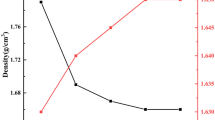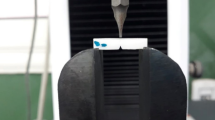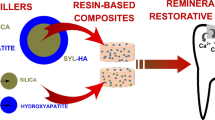Abstract
Layered porous ceramic used for polymer-infiltrated-ceramic-network materials (PICNs) may be a promising candidate for dental restoration. The effect of sintering temperature of ceramic green bodies on mechanical and optical properties of PICNs is unclear. The purpose was to fabricate PICNs and evaluate their mechanical and optical properties. Polymer-infiltrated layered silicates for dental restorative materials were prepared via infiltrating polymerizable monomers into partially sintered porous silicates and thermo-curing. Bending samples for flexural strength and fracture toughness were fabricated (sample numbers of n = 15). Vickers hardness and elastic modulus were measured via nano-indentation (n = 10). One-way ANOVA and Weibull statistics were used for statistical analysis. Optical property was characterized by spectral reflectance. Brittleness index was used to characterize the machinability of the materials. Microstructures and phase structures were investigated using scanning electron microscopy (SEM) and X-ray diffractometer (XRD), respectively. Flexural strength of polymer-infiltrated layered silicates varied from 91.29 to 155.19 MPa, fracture toughness ranged from 1.186 to 1.782 MPa·m1/2, Vickers hardness ranged from 1.165 to 9.596 GPa, and elastic modulus ranged from 25.35 to 100.50 GPa. The formed glass phases at 1200 and 1300 °C showed influences on corresponding optical property, which could be observed from spectral reflectance. A kind of PICNs was fabricated by infiltrating polymerizable monomers into layered porous ceramic networks. Sintering temperature could have dramatic effects on the mechanical and optical properties of porous ceramics and PICNs. These kinds of materials possess similar properties to that of natural tooth and could be used for dental restoration.









Similar content being viewed by others
Change history
20 January 2020
In the original publication, Sect. 2.1 was published incorrectly as below.
References
He LH, Swain M. A novel polymer infiltrated ceramic dental material. Dent Mater. 2011;27(6):527.
Sripetchdanond J, Leevailoj C. Wear of human enamel opposing monolithic zirconia, glass ceramic, and composite resin: an in vitro study. J Prosthet Dent. 2014;112(5):1141.
Kim M, Oh S, Kim J, Ju S, Seo D, Jun S, Ahn J, Ryu J. Wear evaluation of the human enamel opposing different Y-TZP dental ceramics and other porcelains. J Dent. 2012;40(11):979.
Lawson NC, Janyavula S, Syklawer S, McLaren EA, Burgess JO. Wear of enamel opposing zirconia and lithium disilicate after adjustment, polishing and glazing. J Dent. 2014;42(12):1586.
Aboushelib MN, Kleverlaan CJ, Feilzer AJ. Microtensile bond strength of different components of core veneered all-ceramic restorations: Part II: zirconia veneering ceramics. Dent Mater. 2006;22(9):857.
Kelly JR. Clinically relevant approach to failure testing of all- ceramic restorations. J Prosthet Dent. 1999;81(6):652.
Gemalmaz D, Ergin Ş. Clinical evaluation of all-ceramic crowns. J Prosthet Dent. 2002;87(2):189.
Manicone PF, Rossi Iommetti P, Raffaelli L. An overview of zirconia ceramics: basic properties and clinical applications. J Dent. 2007;35(11):819.
Swain MV, Coldea A, Bilkhair A, Guess PC. Interpenetrating network ceramic-resin composite dental restorative materials. Dent Mater. 2016;32(1):34.
Chen M. Update on dental nanocomposites. J Dent Res. 2010;89(6):549.
Ferracane JL. Resin composite—state of the art. Dent Mater. 2011;27(1):29.
Moszner N, Salz U. New developments of polymeric dental composites. Prog Polym Sci. 2001;26(4):535.
Moszner N, Hirt T. New polymer-chemical developments in clinical dental polymer materials: enamel–dentin adhesives and restorative composites. J Polym Sci Part A: Polym Chem. 2012;50(21):4369.
Della Bona A, Corazza PH, Zhang Y. Characterization of a polymer-infiltrated ceramic-network material. Dent Mater. 2014;30(5):564.
Okada K, Kameya T, Ishino H, Hayakawa T. A novel technique for preparing dental CAD/CAM composite resin blocks using the filler press and monomer infiltration method. Dent Mater J. 2014;33(2):203.
Nguyen JF, Ruse D, Phan AC, Sadoun MJ. High-temperature-pressure polymerized resin-infiltrated ceramic networks. J Dent Res. 2014;93(1):62.
Coldea A, Swain MV, Thiel N. Mechanical properties of polymer-infiltrated-ceramic-network materials. Dent Mater. 2013;29(4):419.
Nguyen J, Migonney V, Ruse ND, Sadoun M. Resin composite blocks via high-pressure high-temperature polymerization. Dent Mater. 2012;28(5):529.
Nguyen J, Migonney V, Ruse ND, Sadoun M. Properties of experimental urethane dimethacrylate-based dental resin composite blocks obtained via thermo-polymerization under high pressure. Dent Mater. 2013;29(5):535.
Eldafrawy M, Nguyen JF, Mainjot AK, Sadoun MJ. A functionally graded picn material for biomimetic CAD/CAM blocks. J Dent Res. 2018;97(12):1324.
Satterthwaite JD, Maisuria A, Vogel K, Watts DC. Effect of resin-composite filler particle size and shape on shrinkage-stress. Dent Mater. 2012;28(6):609.
Suzuki S, Nagai E, Taira Y, Minesaki Y. In vitro wear of indirect composite restoratives. J Prosthet Dent. 2002;88(4):431.
Wille S, Hölken I, Haidarschin G, Adelung R, Kern M. Biaxial flexural strength of new Bis-GMA/TEGDMA based composites with different fillers for dental applications. Dent Mater. 2016;32(9):1073.
Randolph LD, Palin WM, Leloup G, Leprince JG. Filler characteristics of modern dental resin composites and their influence on physico-mechanical properties. Dent Mater. 2016;32(12):1586.
Li J, Zhang X, Cui B, Lin Y, Deng X, Li M, Nan C. Mechanical performance of polymer-infiltrated zirconia ceramics. J Dent. 2017;58:60.
Wang H, Cui B, Li J, Li S, Lin Y, Liu D, Li M. Mechanical properties and biocompatibility of polymer infiltrated sodium aluminum silicate restorative composites. J Adv Ceram. 2017;6(1):73.
Cui B, Li J, Wang H, Lin Y, Shen Y, Li M, Deng X, Nan C. Mechanical properties of polymer-infiltrated-ceramic (sodium aluminum silicate) composites for dental restoration. J Dent. 2017;62:91.
Lawn BR, Marshall DB. Hardness, toughness, and brittleness: an indentation analysis. J Am Ceram Soc. 1979;62(7–8):347.
Braga RR, Denry IL, Ferracane JL, Khajotia SS, Mahler DB, Marshall GW, Marshall SJ, Mitchell JC, Mitra SB, Muenchinger KL, Pfeifer CS, Powers JM, Sakaguchi RL. Craig’s restorative dental materials (thirteenth edition). Edited by Sakaguchi RL, Powers JM. Saint Louis: Mosby.2012.16.
Cuy JL, Mann AB, Livi KJ, Teaford MF, Weihs TP. Nanoindentation mapping of the mechanical properties of human molar tooth enamel. Arch Oral Biol. 2002;47(4):281.
Jeng Y, Lin T, Hsu H, Chang H, Shieh D. Human enamel rod presents anisotropic nanotribological properties. J Mech Behav Biomed. 2011;4(4):515.
White SN, Luo W, Paine ML, Fong H, Sarikaya M, Snead ML. Biological organization of hydroxyapatite crystallites into a fibrous continuum toughens and controls anisotropy in human enamel. J Dent Res. 2001;80(1):321.
Della Bona A, Anusavice KJ, DeHoff PH. Weibull analysis and flexural strength of hot-pressed core and veneered ceramic structures. Dent Mater. 2003;19(7):662.
Danzer R, Fischer FD, Lu C. Fracture statistics of brittle materials: Weibull or normal distribution. Phys Rev E. 2002;65(6):67102.
Ruales-Carrera E, Cesar PF, Henriques B, Fredel MC, Özcan M, Volpato CAM. Microtensile bond strength of zirconia after surface treatments and aging. Dent Mater. 2018;34:100.
Sen N, Us YO. Mechanical and optical properties of monolithic CAD–CAM restorative materials. J Prosthet Dent. 2018;119(4):593.
Gradl R, Zanette I, Ruiz-Yaniz M, Dierolf M, Rack A, Zaslansky P, Pfeiffer F. Mass density measurement of mineralized tissue with grating-based X-ray phase tomography. PLoS ONE. 2016;11(12):e167797.
Miyagawa Y, Powers JM, O’Brien WJ. Optical properties of direct restorative materials. J Dent Res. 1981;60(5):890.
Chimanski A, Cesar PF, Yoshimura HN. Effects of glass chemistry on the optical properties of highly translucent alumina-glass biocomposites for dental restorations. Ceram Int. 2017;43(16):13970.
Della Bona A, Nogueira AD, Pecho OE. Optical properties of CAD–CAM ceramic systems. J Dent. 2014;42(9):1202.
Jin J, Li XH, Wu JW, Lou BY. Improving tribological and corrosion resistance of Ti6Al4V alloy by hybrid microarc oxidation/enameling treatments. Rare Met. 2018;37(1):26.
Zhao DP, Tang JC, Nie HM, Zhang Y, Chen YK, Zhang X, Li HX, Yan M. Macro-micron-nano-featured surface topography of Ti–6Al–4V alloy for biomedical applications. Rare Met. 2018;37(12):1055.
Yuan BG, Yu HP, Li CF, Sun DL. Wear properties of nonhydrogenated, hydrogenated, and dehydrogenated Ti6Al4V alloy. Rare Met. 2018;37(7):574.
Cesar PF, Yoshimura HN, Miranda WG Jr, Miyazaki CL, Muta LM, Filho LER. Relationship between fracture toughness and flexural strength in dental porcelains. J Biomed Mater Res B Appl Biomater. 2006;78(2):265.
Acknowledgements
This work was financially supported by Beijing Municipal Science and Technology Commission (No. Z171100002017009) and the National Natural Science Foundation of China (Nos. 51532003, 51221291, 51328203 and 81671026).
Author information
Authors and Affiliations
Corresponding author
Rights and permissions
About this article
Cite this article
Cui, BC., Li, J., Lin, YH. et al. Polymer-infiltrated layered silicates for dental restorative materials. Rare Met. 38, 1003–1014 (2019). https://doi.org/10.1007/s12598-019-01267-6
Received:
Revised:
Accepted:
Published:
Issue Date:
DOI: https://doi.org/10.1007/s12598-019-01267-6




